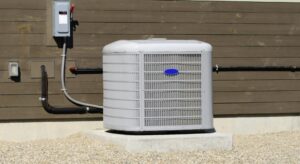
A range hood helps vent smoke, odor and grease out of kitchen air while you cook on your range or cooktop. Proper ventilation makes the kitchen more inviting so you can fry, sear or sauté without worry. Keeping your kitchen air ventilated can help set the tone for each new day of creating. Ventilation is key for cleanliness around your range or cooktop.
This guide will walk you through the different types of range hood vent options and answer common questions about installation, vent speed, size and which hoods are right for which stoves.
What Are the Different Types of Kitchen Ventilation Systems?
There are two primary types of range hood ventilation systems: external venting and recirculating venting. A convertible range hood can switch between the two based on the presence or absence of ductwork in your kitchen. It’s worth noting that professional installation of ductwork is an option if your kitchen layout doesn’t currently support your desired cooking configuration.
External venting directs air through ductwork in the wall, ceiling, or floor, expelling it outside of the house.
Recirculating venting filters air upon entry into the hood and then releases it back into the kitchen. These vent hoods typically require periodic filter cleaning, recommended at least twice a year.
Decorative hoods, such as canopy and downdraft styles, generally vent externally. Conversely, most under-cabinet hoods and microwave hood combinations are factory-set for recirculation. Prior to purchasing a hood, review the online owner’s manual or product specifications to understand its venting method and if it offers convertible functionality. Sometimes, an additional kit is available to convert an external vent model into a recirculating model.
5 Types of Range Hoods for Kitchen Ventilation
Range hoods offer diverse styles and features. If you prioritize ventilating smoke and fumes while cooking, installing a range hood is essential. Explore the various types of range hoods below to determine which one best suits your preferences and kitchen layout.
1. Wall Mount Canopy Range Hoods
Wall-mount canopy hoods offer a range of CFM options and design choices, making them compatible with various cooking appliances. They replace over-the-range cabinetry and typically vent air outside through wall ductwork, though alternative venting options exist.
2. Under-Cabinet Range Hoods
Installed beneath cabinets, these hoods provide a discreet, built-in appearance. Although smaller than canopy hoods, they still deliver powerful venting suitable for diverse home cooking needs. Ductwork can be concealed in the cabinet above or placed in the wall, leaving the cabinet space free for storage.
3. Over-The-Range Microwave Hood Combinations
As the name suggests, these appliances function both as microwaves and vent hoods, allowing for cooking while simultaneously venting smoke and odors from the cooking surface below. These space-saving units elevate the microwave off the countertop while preserving cabinet space above.
4. Island Range Hoods
Suspended from the ceiling over an island range, island canopy hoods serve as a focal point in the kitchen, offering advanced technology and robust performance. Finished on all sides, they often require ceiling ductwork for proper ventilation.
5. Retractable Downdraft Hoods
These concealed vent hoods provide an integrated ventilation solution, remaining flush with the countertop until activated, then rising above the cooking surface. Smoke and odors are vented downward into ductwork beneath the floor, though recirculating kits are also available.
What Options Should I Look for When Buying a Range Hood?
Similar to other kitchen appliances, various types of range hoods provide distinct advantages based on your cooking preferences. Here are key features and options to contemplate when choosing the ideal range hood for your needs:
Size
Ensure your range hood matches the width of the cooking surface below. Most ranges and vent hoods are available in 30″, 36″, 42″, and 48″ widths. Matching the size precisely guarantees full coverage of all burners or elements, effectively capturing any smoke, odor, or grease emanating from them.
Venting Strength (CFMS)
Venting strength, measured in cubic feet per minute (CFM), indicates the airflow capacity of a vent hood. Higher CFM values denote more powerful ventilation. Most vent hoods offer multiple fan speed settings, with CFMs increasing as you move to higher speeds.
BTU Ratings
A vent hood’s BTU rating determines its compatibility with gas ranges featuring burners of corresponding BTU ratings. BTUs (British Thermal Units) measure the heat output of gas burners. While this is primarily relevant for high-BTU commercial-style ranges and hoods, it’s essential to ensure your vent hood can effectively handle both the heat and smoke from the cooking surface below.
Lighting
Clear visibility of the cooktop or range is crucial for monitoring cooking progress. Vent hoods provide ample illumination for the cooking surface below. Opt for models with LED lighting and adjustable brightness levels. Some models, like the KitchenAid® 36″ Low Profile Under-Cabinet Hood, offer a night light setting for a soft, inviting ambiance in the kitchen.
Automatic Speed Adjustment
Convenience is paramount, especially when engrossed in cooking. Premium range hoods may feature automatic activation, sensing when cooking is underway and turning on automatically. Some models even adjust fan speed autonomously, aligning with the heat output of the cooking surface.





